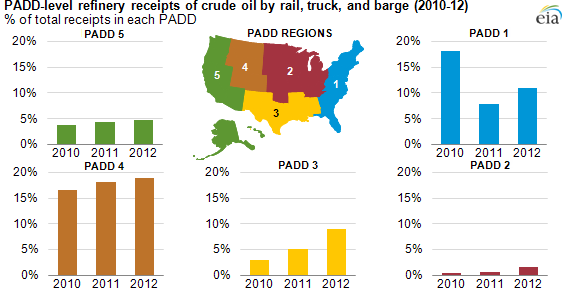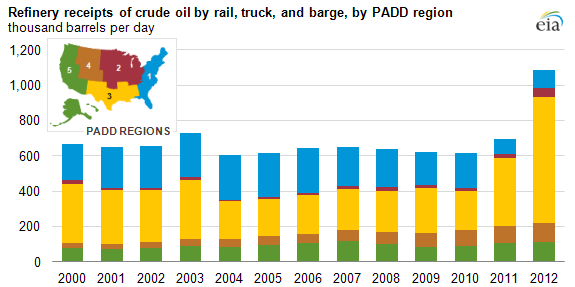
Refinery receipts of crude oil by rail, truck, and barge continue to increase

Note: PADD is Petroleum Administration for Defense District.
The use of rail, truck, and barge to deliver crude oil to refineries has increased, in part due to increases in U.S. crude oil production. The increases, which vary by region, can be seen in EIA's recently released Refinery Capacity Report.
The Gulf Coast (PADD 3) region accounts for most U.S. refinery receipts by rail, truck, and barge. PADD 3, where rail, truck, and barge receipts nearly doubled in 2012, is increasingly dependent on rail and truck to move crude production out of the Eagle Ford and Permian basins to refineries in the area until pipelines are built. In the Rocky Mountain region (PADD 4), domestic truck and pipeline imports of Canadian oil continue to increase as domestic pipeline receipts have stayed flat. East Coast (PADD 1) receipts by rail, truck, and barge decreased in 2011 in part because of refinery closures and increased by 18% in 2012 as a number of refiners put in rail facilities to receive discounted crude from the Bakken and other tight oil formations.

While refinery receipts of crude by truck, rail, and barge remain a small percentage of total receipts, EIA's recently released Refinery Capacity Report shows refineries across the nation received more than 1 million barrels per day (bbl/d) by rail, truck, and barge in 2012, a 57% increase from 2011. Total refinery receipts of crude oil run about 15.2 million bbl/d, with more than half of that crude oil arriving by pipeline.
Truck and rail provide an alternative transportation method when pipelines are operating at capacity or when a production area lacks pipeline infrastructure. Both offer greater operational flexibility than pipelines as they make use of existing road and rail infrastructure near producing basins to move crude oil to refineries that may not be accessible by pipelines. The increase in barge receipts may partially be explained by crude oil being transferred to barges from rail cars for the final leg of some journeys to refineries, particularly on the East Coast and along the Mississippi River. Even as additional pipeline infrastructure is put in place, crude oil is expected to continue moving by rail and truck as economics dictate.

For additional analysis on crude oil movements, see the July 11th edition of This Week in Petroleum and the July 10th Today in Energy.
Tags: liquid fuels, oil/petroleum